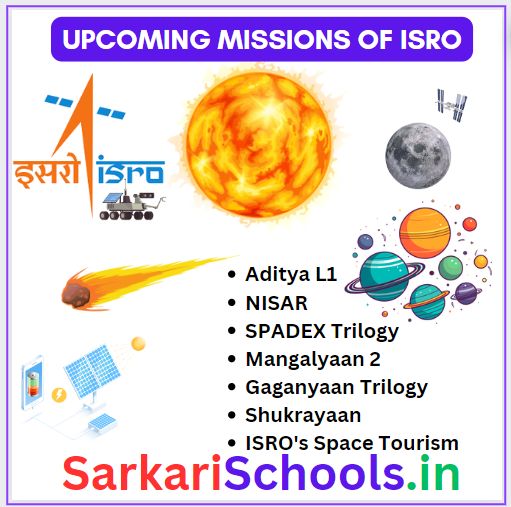Mangalyaan 2 Mars Orbiter Mission 2: Explore the evolution of Mars Orbiter Mission 2 (MOM 2) by ISRO, from its announcement after the success of Mangalyaan, collaboration considerations, funding, and key developments. Discover the focus on advanced scientific payloads, including ionosphere plasma instruments and a suite of cameras and radar, aiming to unveil Mars’ mysteries and geological history
Mangalyaan 2 Mars Orbiter Mission 2: India’s Odyssey to the Red Planet Continues
| Aspect | Information |
|---|---|
| Project Name | Mars Orbiter Mission 2 (MOM 2) |
| Announcement | Announced after the success of the Mars Orbiter Mission (Mangalyaan) |
| Launch Vehicle | Planned to use the LVM3, a more powerful launcher |
| Evolution of Design | Considered including a lander, but clarified as an orbiter-only mission |
| Collaboration | Initial joint plan with France (ISRO and CNES) for construction, later status uncertain |
| Funding | Funded by the Indian government’s 2017 budget proposal |
| Development Phase | Instruments selected through an Announcement of Opportunity |
| Payload Mass | Estimated at 100 kg |
| Key Payload | Ionosphere plasma instrument named ARIS |
| Payload Progress | ARIS development by Space Satellite Systems and Payloads Centre (IIST) |
| Scientific Arsenal | Hyperspectral camera, very high-resolution panchromatic camera, radar |
| Scientific Focus | Understanding early Martian stages, crust, basalts, and ongoing activities like boulder falls |
| Path Ahead | MOM 2 marks ISRO’s commitment to advanced interplanetary exploration |

In a resounding testament to India’s space prowess, the nation’s ambitions are set to soar once again with the eagerly awaited Mangalyaan 2, also hailed as the Mars Orbiter Mission 2. Following the remarkable success of its predecessor, Mangalyaan 2 stands poised to etch another chapter in ISRO’s interplanetary journey, with a slated launch in the year 2024.
As the Mars Orbiter Mission’s triumphant successor, Mangalyaan 2 will embark on an audacious odyssey to Mars, aiming to uncover the enigmatic secrets held by the Red Planet. At its heart, the mission underscores ISRO’s unyielding commitment to unraveling Mars’ mysteries and enhancing our understanding of the solar system’s fourth planet.
Central to Mangalyaan 2’s arsenal of scientific instruments is an array of cutting-edge technology, including a hyperspectral camera, a high-resolution panchromatic camera, and a radar system. These sophisticated tools are meticulously designed to delve into Mars’ geological past, peering into its early crust, recent volcanic activity, and even the tales told by boulder falls.
Mangalyaan 2’s journey serves not only as a testament to India’s scientific capabilities but also as a beacon of global collaboration, inviting the world to participate in this bold expedition. As the launch date nears, excitement courses through the veins of the scientific community and space enthusiasts alike. Mangalyaan 2’s path to the Red Planet promises to enrich our understanding of Mars’ evolution, inspire new generations of explorers, and pave the way for a future characterized by interplanetary discovery.
Mars Orbiter Mission 2 (MOM 2): Delving into Martian Enigmas
Unveiling the mysteries of Mars once more, the proposed Mars Orbiter Mission 2 (MOM 2) by the Indian Space Research Organisation (ISRO) holds the promise of renewed exploration beyond Earth’s bounds. While early discussions hinted at the inclusion of a lander, clarifications from ISRO’s chairman underscored that the mission’s core will consist solely of an orbiter.
A New Quest in the Martian Realm
Projected for a launch by the year 2024, MOM 2 is poised to embark on a fresh quest to decode the secrets of the Red Planet. Unlike its predecessor, this mission sets its focus on the orbiting component, intending to enrich our understanding of Mars through advanced observational capabilities.
Instrumentation for Insight
MOM 2’s orbiter will bear the weight of three remarkable instruments that promise to unravel Mars’ mysteries. A hyperspectral camera, a high-resolution panchromatic camera, and a radar system will serve as its eyes and ears, capturing intricate details etched across the Martian landscape. These tools are tailor-made to decipher the planet’s past, from its earliest geological formations to its recent volcanic activities and the intriguing phenomenon of boulder falls.
Innovative Orbit-Shaping: Aerobraking
A striking feature of MOM 2’s design is its use of aerobraking, a novel technique that leverages the Martian atmosphere to fine-tune the orbiter’s trajectory. By skillfully navigating through the thin layers of Mars’ atmosphere, the orbiter will lower its initial apoapsis, ultimately settling into an orbit better suited for conducting its observational mission.
Peering into the Future
With its sights set on Mars, MOM 2 exemplifies ISRO’s unwavering commitment to unraveling the mysteries of the cosmos. As the launch date draws nearer, the mission holds the potential to unveil fresh insights into the enigmatic Martian landscape, enhancing our understanding of the planet’s evolution and offering a tantalizing glimpse into its geological past.
Evolution of a Second Martian Odyssey: A Historical Overview
The seeds of the Mars Orbiter Mission 2 (MOM 2) were sown in the wake of India’s triumph with the Mars Orbiter Mission (Mangalyaan), a landmark achievement that catapulted the Indian Space Research Organisation (ISRO) onto the international stage. The announcement of MOM 2 took shape during the Engineers Conclave conference in Bengaluru on 28 October 2014, marking the beginning of a new chapter in India’s interplanetary aspirations.
A Vision Reshaped: MOM 2 Takes Form
With the successful insertion of Mangalyaan into Martian orbit, ISRO unveiled its bold intent to further explore the enigmatic Red Planet. The propulsion for this endeavor was to be provided by the LVM3, a launch vehicle that showcased its mettle during its maiden flight on 5 June 2017. Unlike its predecessor, Mangalyaan, the upgraded propulsion capacity of the LVM3 holds the potential to propel MOM 2 on a direct-to-Mars trajectory, offering greater payload capabilities.
Global Collaborations and Funding
Collaboration with France emerged as a promising avenue in MOM 2’s evolution. A letter of intent was signed between India and France in January 2016, envisioning a joint effort between ISRO and CNES to build MOM 2 by 2020. However, as of April 2018, France’s involvement in the mission remained uncertain, hinting at the intricate complexities of international collaboration in space exploration.
The Pathway Ahead: Orbiter Mission with Enhanced Instruments
As funding for MOM 2 was secured through India’s 2017 budget proposal, ISRO embarked on a strategic decision-making process. The organization weighed the prospect of a comprehensive mission involving an orbiter, lander, and rover against the option of an orbiter alone, equipped with more sophisticated instruments than those on Mangalyaan. Amidst this deliberation, S. Somanath, the director of the Vikram Sarabhai Space Centre, hinted in a podcast recording in October 2019 that MOM 2’s architecture was still under consideration, potentially encompassing a lander and rover, though without specifying a timeline.
MOM 2’s Definitive Shape: Orbiter Mission
In a pivotal announcement in February 2021, ISRO revealed its course of action for MOM 2. The organization issued an ‘Announcement of Opportunities,’ affirming that Mangalyaan 2 would exclusively manifest as an orbiter mission. This decision marked a crystallization of the project’s direction, signifying ISRO’s strategic focus on enhancing its interplanetary capabilities through advanced orbiter-based exploration.
The saga of MOM 2’s evolution stands as a testament to ISRO’s dynamic spirit, adaptability, and unwavering commitment to expanding the frontiers of space exploration. With its trajectory firmly set as an orbiter mission, MOM 2 continues to march towards its destiny, poised to unlock new vistas of Martian knowledge and cement India’s position as a pioneer in interplanetary exploration.
From Concept to Reality: The Development of MOM 2
The journey of crafting Mars Orbiter Mission 2 (MOM 2) extends beyond aspirations, entering the realm of meticulous development and engineering. This endeavor, driven by the Indian Space Research Organisation (ISRO), unveils a tale of innovation, collaboration, and cutting-edge technology.
Calling for Scientific Contributions
The stage was set in the form of an ‘Announcement of Opportunity,’ a clarion call for scientific instruments that would adorn MOM 2’s orbiter. Released to the scientific community, this opportunity beckoned experts to submit their proposals for instruments that would adorn the mission’s orbiter component. The deadline for these submissions was set for 20 September 2016, fostering a collective effort in shaping the scientific agenda of the mission.
The Weight of Science: Payload Considerations
Central to the orbiter’s mission is its scientific payload, a trove of instruments poised to unravel the secrets of Mars. With an estimated total mass of 100 kg, these instruments hold the key to unlocking the Red Planet’s mysteries, casting light on its geological past, and capturing the essence of its ongoing activities.
ARIS: Illuminating the Ionosphere
Among the prominent payloads in development is the ionosphere plasma instrument named ARIS. Housed within the Space Satellite Systems and Payloads Centre (SSPACE), a component of the Indian Institute of Space Science and Technology (IIST), ARIS is a testament to India’s homegrown expertise. Progressing steadily, ARIS has reached significant milestones, including the completion of its engineering model and high vacuum testing.
A Multifaceted Scientific Arsenal
In a noteworthy panel discussion held in September 2022, intriguing details of MOM 2’s scientific payload were unveiled. The mission is set to encompass a trio of powerful instruments, including a hyperspectral camera, a very high-resolution panchromatic camera, and a radar system. These instruments collectively strive to unravel Mars’ early history, examine its evolving geological features such as basalts, and capture ongoing phenomena like boulder falls.
Forging Ahead: A Bright Tomorrow Beckons
As development progresses, MOM 2 emerges as a harmonious convergence of science, engineering, and exploration. With each meticulously crafted instrument, the mission inches closer to unveiling the enigmatic Mars in ways previously unimagined. This development phase epitomizes ISRO’s pursuit of excellence, culminating in an interplanetary endeavor that not only reflects India’s technological prowess but also holds the promise of expanding our understanding of the cosmos.




